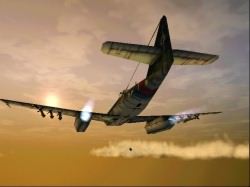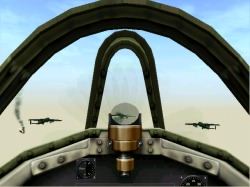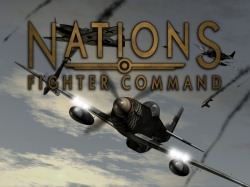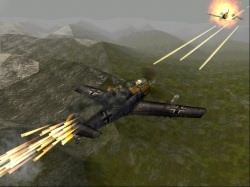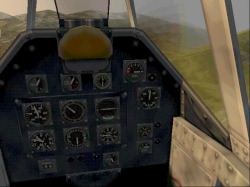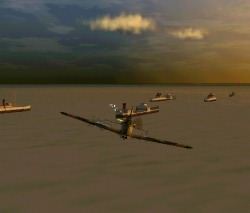| Interview with Craig Penrice, RAF Pilot and Consultant to
Nations - WWII Fighter Commandô
|
||||
|
10. Did you want to fly from a very young age, was it something that was in your blood? I was always interested in aviation from as far back as I can remember. I made a huge number of Airfix models as a child. My parents' house lay under the approach path to Glasgow airport and I must admit to having been a "spotter" for several years. Through school I wanted to become an airline pilot for BOAC as well. Luckily for me the oil crisis of the mid-seventies meant that there was no recruitment into the airline world, indeed newly trained pilots were being offered jobs as cabin stewards following their training. The only option available was therefore the RAF, who thankfully accepted me and I never looked back. 11. And now you're a test pilot for British Aerospace - what planes do you get to fly there? My prime area of responsibility is towards the development flight testing of Eurofighter. In addition to this I am also involved in production flight testing of the Hawk and Tornado aircraft. The job also involves a great deal of work in the simulator, checking that new configurations are safe in theory before taking them into the air. Another major aspect of my work is in working closely with the system design engineers to help them maintain an operational perspective during the design process, this is often vital in ensuring a product that will meet the requirements of the customer.
12. What is it that excites you about flying the most? Ask any pilot that question and I'm sure you will get an answer along the lines of "flying is all consuming". It is very hard to put your finger on one aspect of it that excites the most. I often say that it is not difficult to fly an aircraft, but it is difficult to fly an aircraft well. To a military pilot, flying the aircraft well is a very small part of the job. Operating the aircraft, sometimes to the limit of its and your capabilities, day or night in sometimes horrible weather and achieving the aim of the mission is a very satisfying experience. The aim of the mission may be to defend a piece of airspace or to get your bombs on target on time, regardless of weather, threat aircraft or many other factors. Equally, the thrill of airshow flying, putting the aircraft through its paces for a crowd, safely but still entertaining is another great experience, almost artistic in a way but yet the skill of precise and accurate control is the challenge to master. 13. So, you fly brand-spanking new planes before anyone else but you also fly vintage aircraft in your spare time - how did that come about? Like many good things it happened because I happened to be in the right place at the right time. An old friend was involved with trying to organise a 4-ship formation of Hunters to take part in the Biggin Hill airshow when I met him again after some years. Being current in the Hunter through my job at Boscombe Down, he asked if I was interested in helping him out. Of course I jumped at the chance and it was just a matter of getting the appropriate approvals and validations to satisfy the CAA in time to practice before the first show. I am also involved a couple of times a year in running a school to teach formation flying to civilian private pilots. This is mostly done in aircraft such as the Yak-52, Harvard, Chipmunk and Zlin. Formation flying is a basic skill of any military pilot, but it is not a skill that is gained without considerable practice and cannot be picked up as you go along. There is a great deal of discipline involved both in terms of procedures and in flying skills to keep your aircraft in the correct position. I enjoy trying to convey those skills and disciplines to pilots who have not been brought up in a military training environment. |
14. What sort of aircraft do you get to play with? My airshow flying has been limited to the Hunter aircraft, albeit a variety of quite significantly different marks of the original design, both single seat and two seat versions with both large and small engines. The aircraft are all civil registered, which means that you operate them under a whole different set of rules than the military aircraft I am more used to operating. I have been offered spots flying in a couple of other types, namely the Sea Fury, MIG-15 and Yak-52. At the moment I feel that I cannot repay the owners financial outlay in training me on the aircraft, since I have a number of other commitments which limit my availability to recoup the costs through airshow income for the plane's owner. I would like to get involved with more types, but there is a limit to the time available to balance work, family and fun. 15. Where do you fly them? I have been all round the UK and as far afield as France, Belgium and Austria to display. These are old aeroplanes and they do not get to fly nearly as much as they once did in military service, so you don't undertake a major transit flight lightly. I certainly would not consider flying to Austria, for example, in anything other than ideal weather, indeed you are quite limited by regulations in this respect. 16. Which of these planes has been the most exhilarating experience? I think the most exhilarating experience was flying a display at a small lakeside village high up in the Austrian Alps in a valley that was only just wide enough to turn round in. It was a crystal clear day and there was still a lot of snow covering the higher mountain peaks. It was staggeringly beautiful and it was like flying in my own little mountain amphitheatre. 17. Have you had any hairy incidents? I think you could say I have. I had to eject from a Lightning when the flight control system malfunctioned and the aircraft decided that it wanted to roll left without me asking it to do so. Luckily I was quite high when it started to do this, but very quickly the rolling developed into a rapidly spiralling dive, which I could do nothing about. I had no option but to eject. Unfortunately because of the speed at the time I ejected (around 570 mph), I suffered badly from windblast and whiplash injuries. I ended up with 13 nuts and bolts in my elbow and 10 in my knee, 3 months in a wheelchair and a year off flying while I recovered.
18. Do you have any aviation heroes? If so, who are they? I think my aviation heroes would be people like Doddy Hay and Bernard Lynch who were the "dummies" for a great number of ejection seat tests made by Martin Baker in the early days of ejection seat development. If it were not for them, a good number of my friends and I would not be here today. I cannot thank them enough. Go to our Nations Interview
|
|||
|
© 1997 - 2000 COMBATSIM.COM, INC. All Rights Reserved Last Updated January 25th, 1999 |
||||

